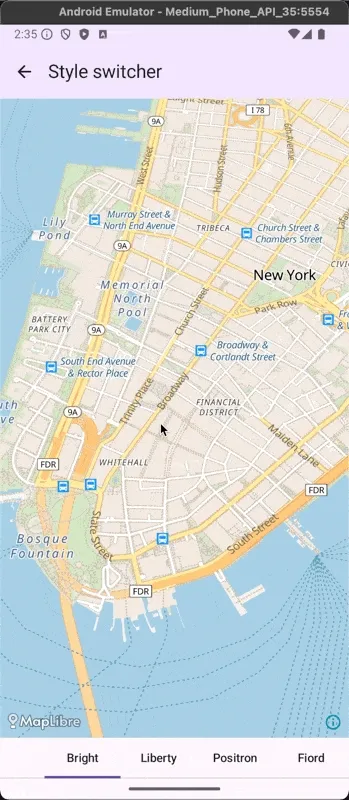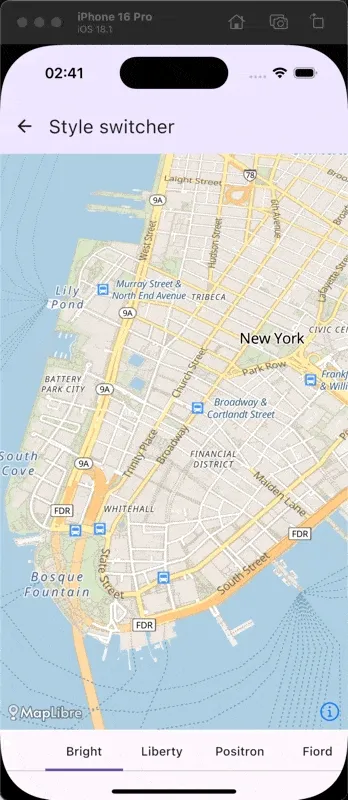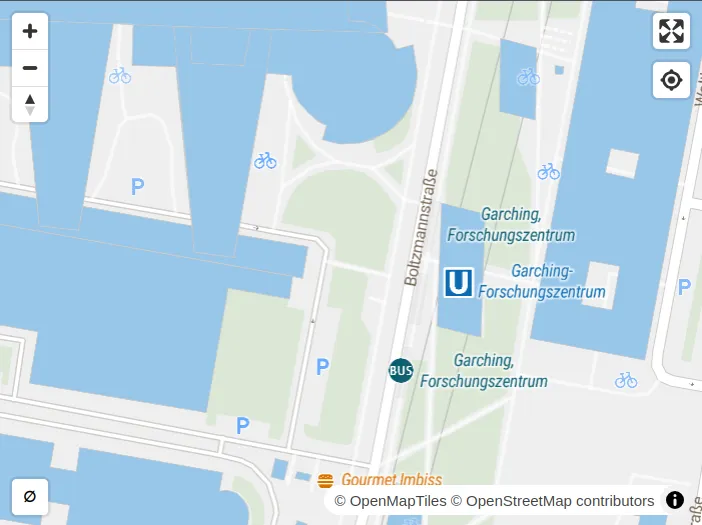Jan 5, 2025
Happy New Year, MapLibre Community! We are thrilled to share big updates for MapLibre Native (including Vulkan support), the official launch of MapLibre GL JS Version 5.0, new features in Martin Tile Server, and more.
In January we will hold a MapLibre Eastern Call again to better connect with contributors around the world.
Let’s dive in!
MapLibre Native
- MapLibre Android 11.7.0 and 11.7.1 were released. These versions mark the first-ever releases with Vulkan support. Check out the detailed announcement on MapLibre Android Vulkan Support.
- The latest version of MapLibre iOS 6.9.0 is here.
Kotlin Multiplatform
Exciting news for developers interested in Kotlin Multiplatform: Sargun Vohra, with input from Tobias Zwick, has released MapLibre for Compose!
The library integrates MapLibre iOS and MapLibre Android and is open to contributions. Experiments that add desktop support as well as support for the web (by integrating with MapLibre GL JS) are underway.
Originally released late November, the library is now at v0.4.0. Get started here:
- 📂 Repository: GitHub Repo
- 📖 Documentation: Explore Docs
Here’s a sneak peek of MapLibre for Compose in action:


MapLibre GL JS
We’re thrilled to announce the official release of MapLibre GL JS Version 5.0! 🌏
This major release, shaped by feedback and several pre-releases (including 5.0.0-pre.9, 5.0.0-pre.10 released in December 2024), introduces globe rendering mode, providing a more immersive experience. It doesn’t mean it’s perfect, nothing is, we will continue to improve it, fix bugs and add new features, but we feel it is ready to see the world and get a wider audience.
Try it out and share your thoughts!
Martin
Martin Tile Server v0.15.0 will have been released™:
While there are a lot of improvements, here are the stand out features:
- COG Support: Basic
cog(Cloud Optimized GeoTIFF) support was added as a data source. This allows to effectively serve raster tiles similar to mbtiles raster mode and pmtiles raster mode. See our docs for further context. - Web UI framework: We have laid the foundation for a web-UI, though it is still in early development. Get a glimpse of our vision for the UI by visiting this GitHub issue.
- SDF sprites:
SDFsprites can now be generated via a separate API route. This allows to color sprites inmaplibre-gl/maplibre-nativebased on map data and have crispier sprites. Limitations include:-
Single-color support only.
-
Background customization limited to blurred borders.
Learn more in the Martin docs. Here’s an example sprite from NavigaTUM:
-

Flutter MapLibre
Started in September 2024, the Flutter maplibre package was created to provide modern Flutter bindings for MapLibre Native and MapLibre GL JS and a seamless integration into the Flutter ecosystem. Currently, supported platforms are Android and Web, while the iOS implementation is on the way and, as of right now, about halfway done (see #26).
Key features include its integration into the Flutter state management system and widget tree, direct interoperability using FFI and JNI, and platform-invariant customizable user interface. A more in depth comparison with flutter-maplibre-gl and other similar packages can be found in the maplibre docs: flutter-maplibre.pages.dev/compare/.
The package already receives a couple of hundred downloads each month, and its goal is to become a full alternative to flutter-maplibre-gl by the end of Q1 2025.
- Repository: github.com/josxha/flutter-maplibre
- pub.dev Package Registry: pub.dev/packages/maplibre
- Hosted Example App: flutter-maplibre.pages.dev/demo
Community Events
MapLibre User Group Japan recently held its 8th X Space on December 26, 2024, attracting 44 listeners! 🎉 If you missed it, you can catch the recording on X.
For more information, visit the official website: https://mug-jp.org.
Monthly Meetings
We’re continuing our tradition of meeting on the second Wednesday of each month, and now we’re adding an additional session on the last Wednesday to accommodate eastern-friendly time zones.
Second Wednesday Meetings (January 8, 2025)
- MapLibre Navigation: 5:00–6:00 PM UTC
- MapLibre Native: 6:00–7:00 PM UTC
- MapLibre GL JS: 7:00–8:00 PM UTC
Last Wednesday Meeting (Eastern-Friendly)
- MapLibre Eastern Call: January 29, 2025 - 9:00–10:00 AM UTC
View meeting times in your time zone: https://notime.zone/OFrb-hOVMIx8E.
All calls are open to everyone. Zoom links can be found in our MapLibre Slack. If you’re not a member, request an invite at https://slack.openstreetmap.us/. We look forward to seeing you!